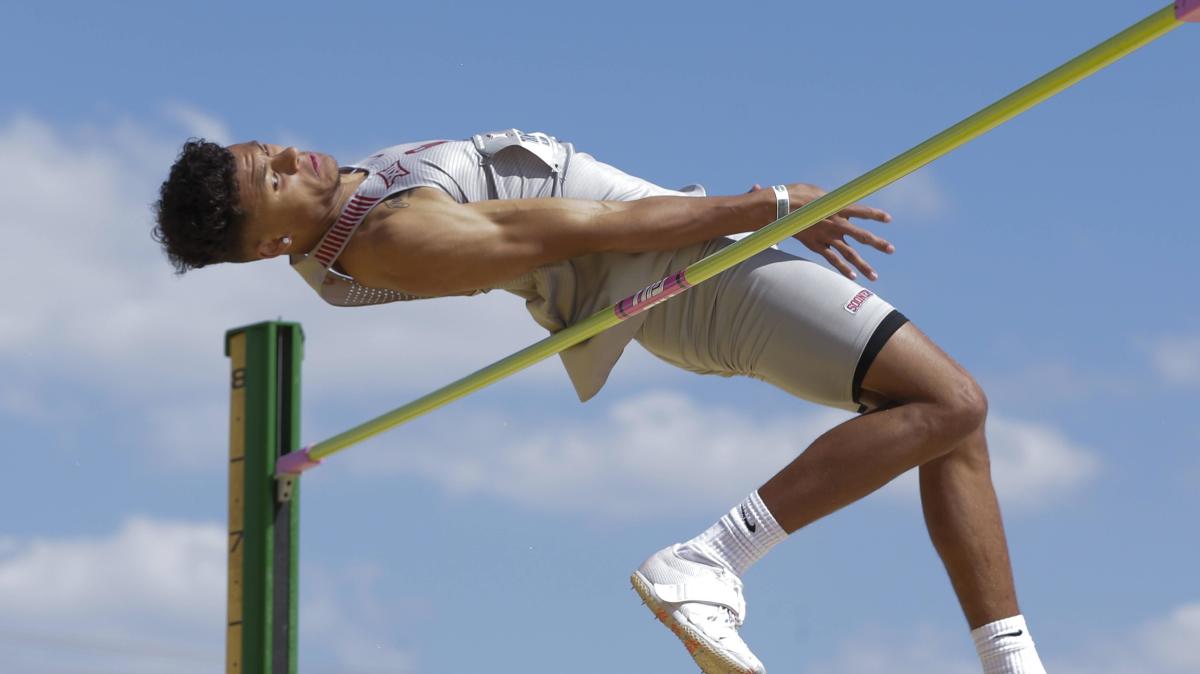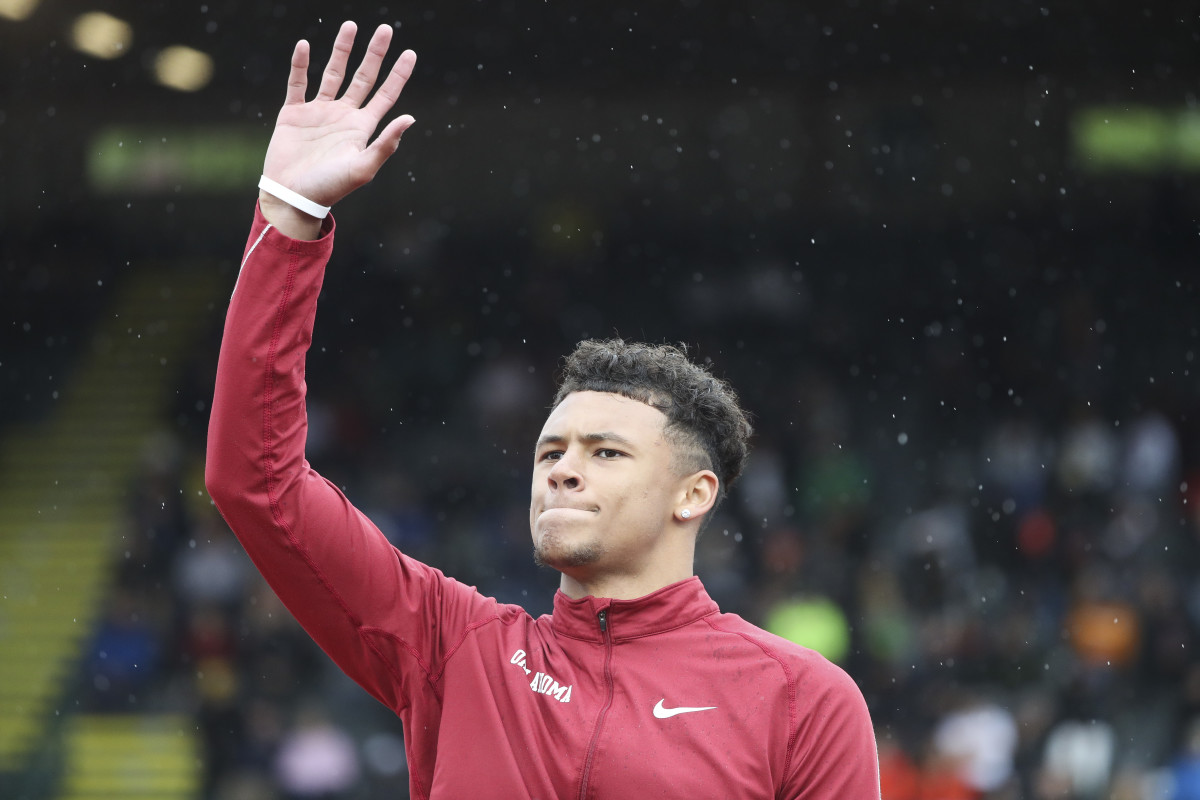OU Olympics, on Hold: Sooners High Jumper Vernon Turner Staying Ready for His Chance

With his return to collegiate track and field disrupted by pandemic, Oklahoma high jumper Vernon Turner had already shifted his focus to the U.S. Olympic Trials.
Then the Coronavirus shut down the Olympics.
“It’s just super frustrating,” Turner told SI Sooners.
“It took me a while to process that,” Turner said, “ … Because losing at the Trials my junior year in high school (he recorded a "no height"), I had promised myself I wouldn’t feel that feeling again, and knowing that this year I would have been able to come back and overcome and succeed in that spotlight again, that is what was pushing me through the season.”
All is not lost. Far from it. The Tokyo Olympics have been postponed until 2021. Turner, an OU sophomore, can get his spring season back if he wants it. He’ll have a lot more opportunities to scrape the clouds.
But for a kid who’s already endured repeated setbacks, it’s tough.
“It’s just — just having my dreams so close,” he said, “and then just having them pulled back further for a year.”
Turner signed with OU out of nearby Yukon High School, but after his freshman year — in which he set school records and won the 2018 Big 12 Conference championship — he transferred to Arkansas. He spent a semester there, but then after a coaching change in Norman, transferred back to OU. Turner’s transfer eligibility appeal was approved the first time, but not the second. So he sat out the entire 2019 season.

Finally back in the pit in 2020, Turner might have been on his way to another monster collegiate season — he got second in the Big 12 Indoor Championships with a jump of 7-foot-1 1/2 — and possibly even international glory.
But instead of perfecting his steps in Oregon and packing for two weeks in Japan, he’s jogging around his neighborhood and lifting weights at home.
“It used to just be the regular routine, just class and practice,” Turner said. “But now it’s super hard because everything is closed. You gotta get it wherever you possibly can. Luckily I have dumbbells at the house, so I can do some weights. But mostly I just go to the park and run, or through the neighborhood, and try to train that way. It’s been kind of hard.”
Dumbbells and morning jogs don’t do much to keep a high jumper sharp. High jump and pole vault are the most technical of all track and field disciplines. Without a surface to work on the approach, without a bar to jump over, without a pit to land in, it’s simply impossible to practice.
“I just don’t right now,” Turner said.
“Technically, on high jump, there’s not a lot you can do,” said Turner’s high school coach, Kevin Ritter. “There’s some plyometric stuff. It’s all gonna be a lot of strength and conditioning stuff you can do. But that’s everybody. Everybody’s in the same boat right now.”
“I can try to do like circle runs or work on my approach a little,” Turner said, “but there’s not really much I can do without the jumping part. I mean, I’ve tried to do my approach a couple times while I was running, but it’s kind of hard to do it on grass. My spikes don’t catch, or I guess in that case my training shoes don’t catch. It’s just super hard, and frustrating.”

Ritter said he has watched video of Turner’s recent competitions and identified some technique issues he needs to clean up. But it’s already difficult to maintain an elite proficiency in the sport. During a pandemic, it’s impossible.
“High jump is very technical because it’s three-dimensional,” Ritter said. “Long jump is two-dimensional, forward and up. Long jump, you’ve got three dimensions going on, so when you rotate and one thing is off, it really affects everything else.
“As do most jumpers, he’s gonna want to start leaning before he ever gets off the ground. In my opinion, it’s your approach. If your approach is off, you’re gonna do that. It’s something you cannot avoid if you’re doing things wrong. Because if you take off going straight up, you’re automatically going into the bar. You have to come at it at angle with your plant foot, and if that plant foot is not in the right angle, you’re not gonna take off vertical, therefore you’re gonna go into the bar.”
“My last two steps, I’m over-rotating,” Turner said. “So I’m not allowing my body to go up. I’m just turning before I’m even off the ground. It’s just throwing me straight into the bar.”
For now, he’s just focusing on strengthening an ankle sprain and, Ritter said, keeping off any unnecessary pounds. Any track facilities where he might get in some practice are closed. Turner said Ritter offered the Yukon facilities whenever they open, but Turner figures by then he’ll be able to return to OU.
“I mean, it’s just crazy,” Turner said. “I never thought it would come to this.”
Turner’s Olympic dreams are still within reach. Actually, they always have been ever since he started jumping competitively in high school.
He was a three-time state champion at Yukon, but that’s usually no indicator of an Olympian. In Turner’s case, however, it was. He jumped 7-4 1/2 as a junior in 2016, which was the top high school jump in the nation. Then his senior year in 2017, he set the National Federation of High Schools mark at 7-6, a number that still stands.
Turner’s best outdoor jump at OU (7-5 3/4) in 2018 would have been good enough to win any of the past five NCAA championships. Turner has also jumped 7-7 3/4 indoors, a height that matched what got American Erik Kynard a silver medal in the 2012 London Games. (Kynard jumped the same height in Rio in 2016 to finish sixth.)
The world record is 8-0 1/2, and the American record is 7-10 1/2. Those certainly seem safe, but Turner might have a legitimate shot at 7-9 someday. A jump like that at the right time could produce a gold medal.
Realistically, Turner has a long way to go, literally, to clear that bar. After transferring twice, sitting out last season and nursing a severe ankle sprain (playing basketball), his top jump in 2020 was 7-3 1/4 at the Razorback Invitational on Jan. 31, and his top finish was second (7-1 1/2) to Kansas State’s Tejaswin Shankar at the Big 12 meet.
Those are good, but might not be good enough to get a spot on Team USA. The top three jumps at the 2016 Olympic Trials were 7-6, 7-4 3/4 and 7-3.
Then again, considering where Turner’s career has taken him so far and how he’s bounced back, the Coronavirus shutdown might actually work to his benefit.
“I think last year, sitting out a year, I think that will actually come around and be a blessing,” he said. “That should be able to help me because I’ll be used to having to sit out and coming back and getting started again. So I think that’ll give me a little bit of an advantage over people that maybe haven’t had to take time off.”
Other than the obvious (Kynard is a former two-time national champion at Kansas State and a 10-time USATF national champion with a PR of 7-9 1/4), Turner said his “most consistent competition” for a spot on the 2021 Olympic team probably will come from former Texas Tech jumper Trey Culver (a two-time national champ and three-time Big 12 champ) and LSU’s Ja’Vaughn Harrison, won won the 2019 NCAA title with a jump of 7-5 1/4 and then pulled off the unprecedented feat of also winning the NCAA long jump title.
Kynard jumps professionally for Nike and Jordan brand, Culver is a professional jumper with Adidas. That’s a career move that Turner has strongly considered as he pursues his degree in Human Resources from OU.
“I’ve thought about it a lot, actually,” he said. “ … That’s always been on the table. But lately, I’ve just been wanting to graduate. Because I don’t want to hurt myself and then have nothing to lean back on. But definitely, if not this next year — I’ve already told my coach, if I make the (Olympic) team, then I’m definitely going pro. I’ll just graduate online. But if not, then I’ll just go back, graduate, probably go to grad school and then go pro. See where I’m at then.”
Turner said within a period of 5-6 days, his world went from focusing on the NCAAs to the U.S. Olympic Trials to online classwork to jogging through the park. The Trials were scheduled to begin in Eugene, Oregon, on June 19. The University of Oregon and USATF were even debuting a brand new track facility for this year’s event.
“I was definitely ready to be back on that stage,” Turner said, “and just prove that I am good enough to be there.”
To get the latest OU posts as they happen, join the SI Sooners Community by clicking “Follow” at the top right corner of the page (mobile users can click the notifications bell icon), and follow SI Sooners on Twitter @All_Sooners.
